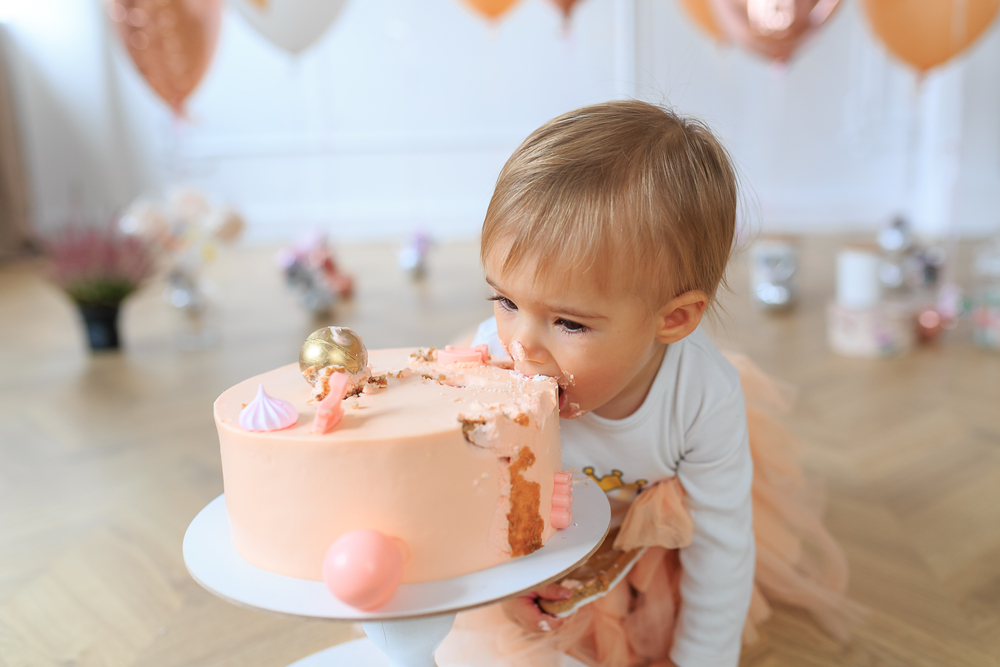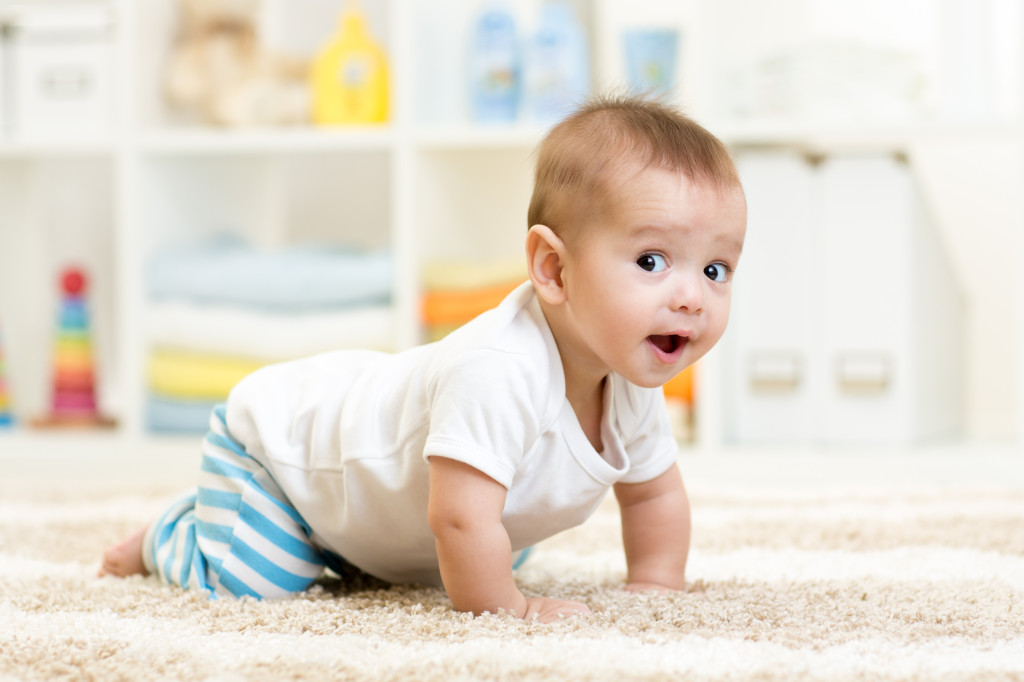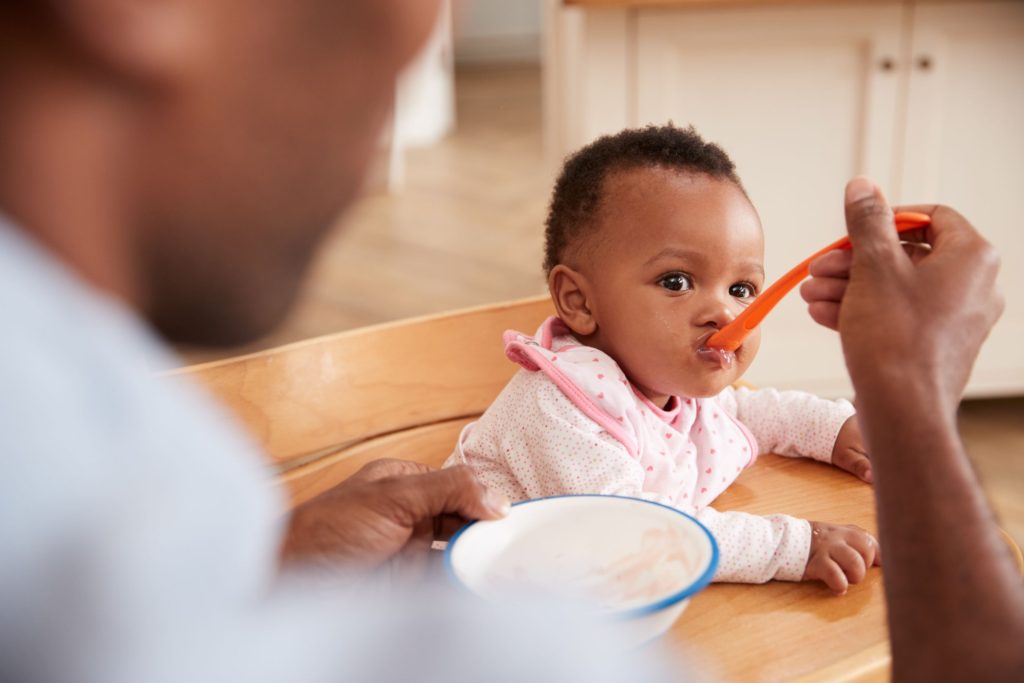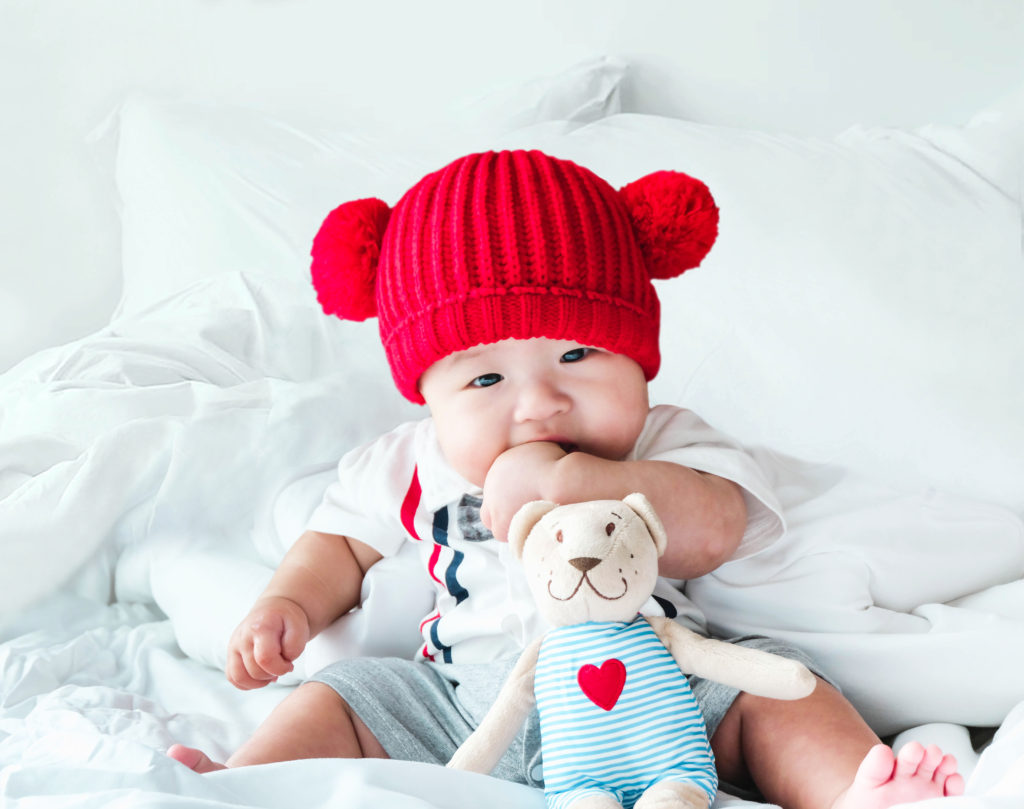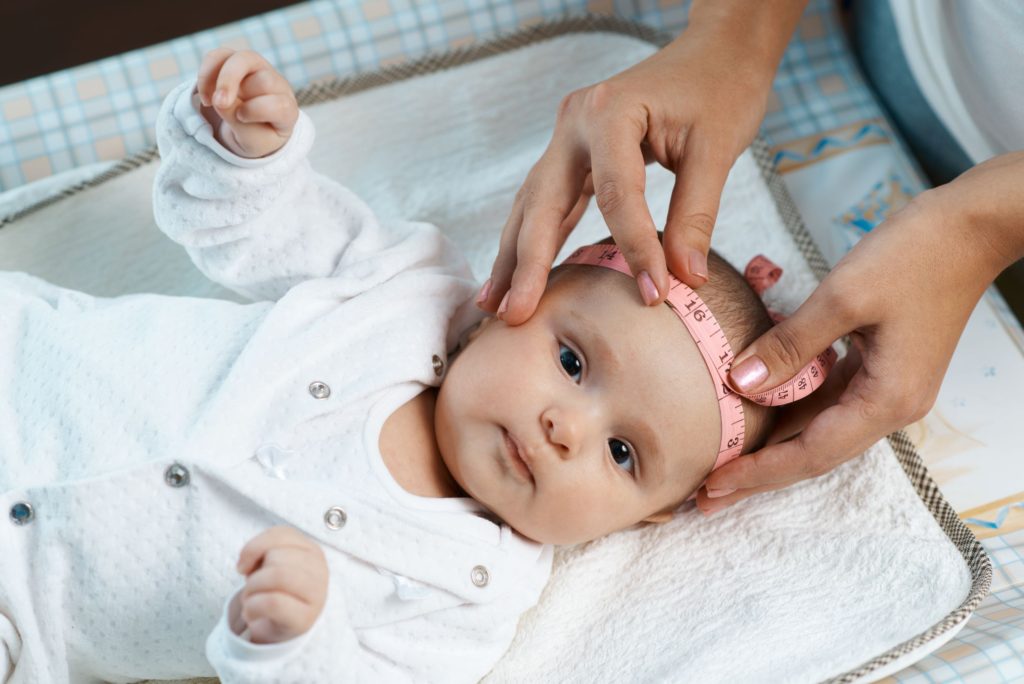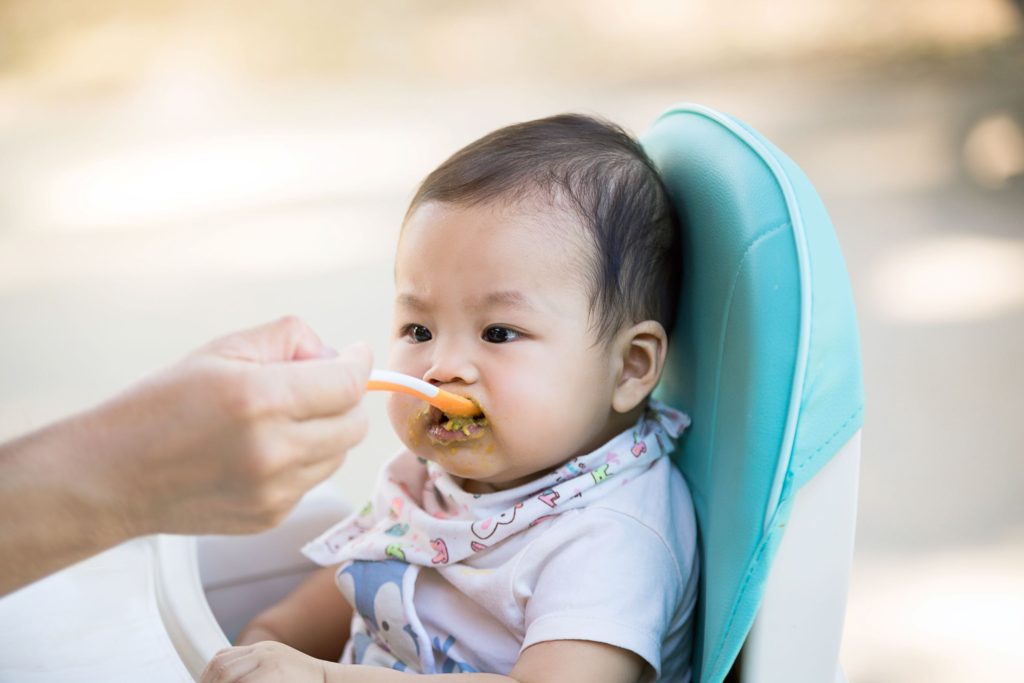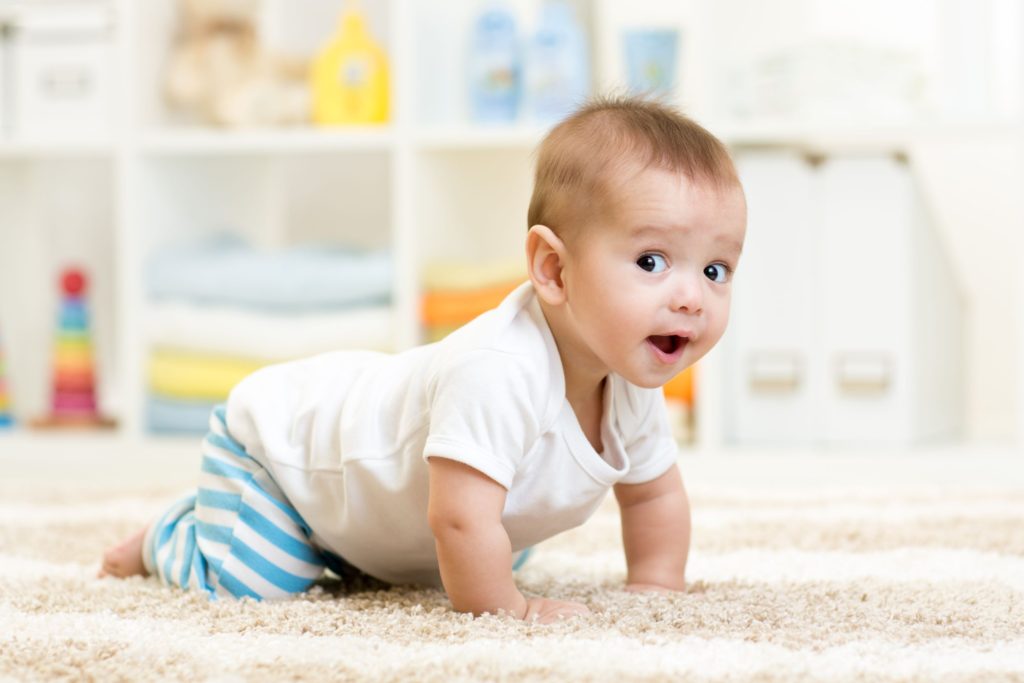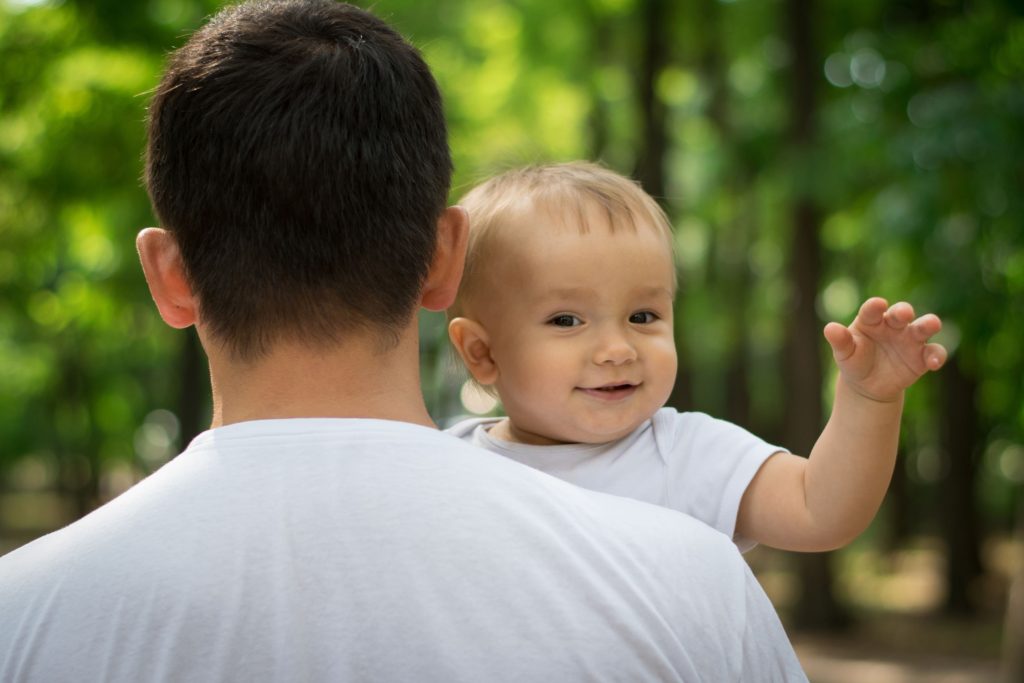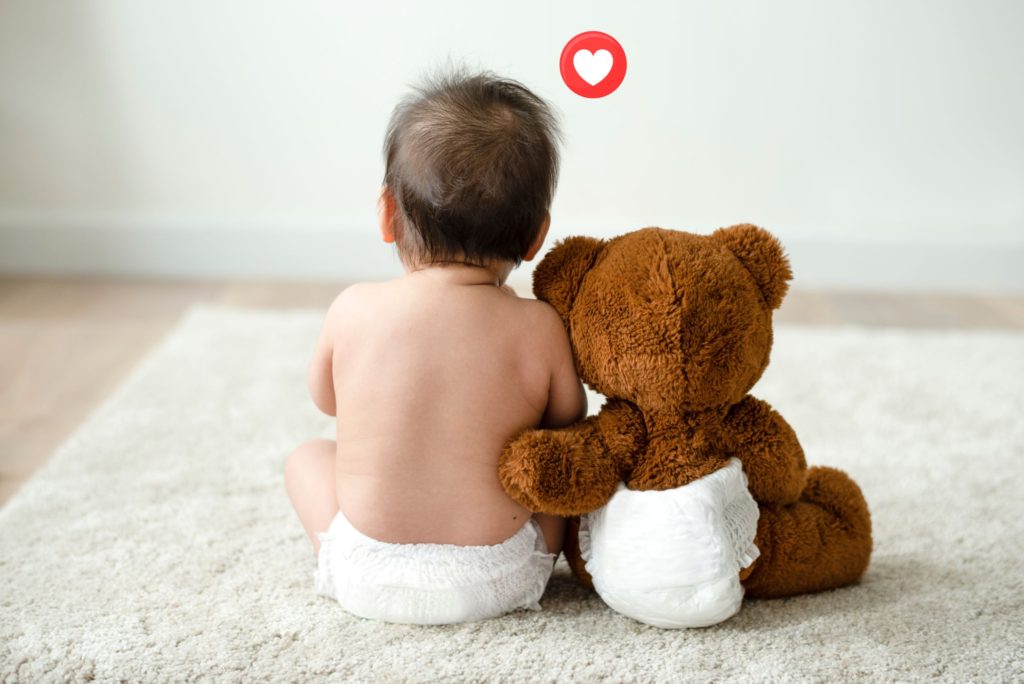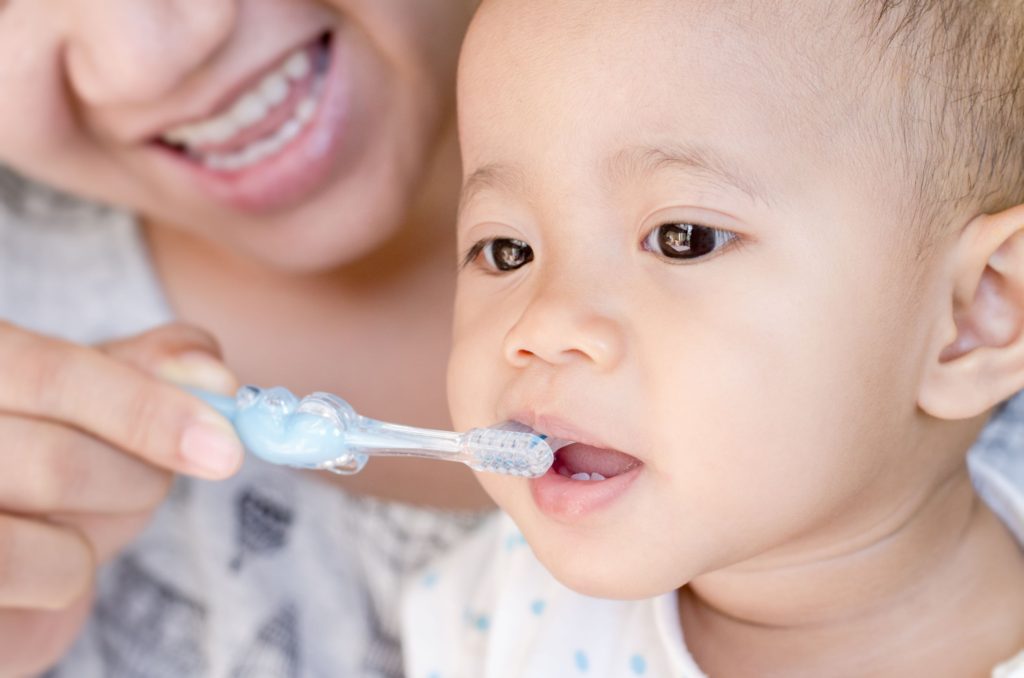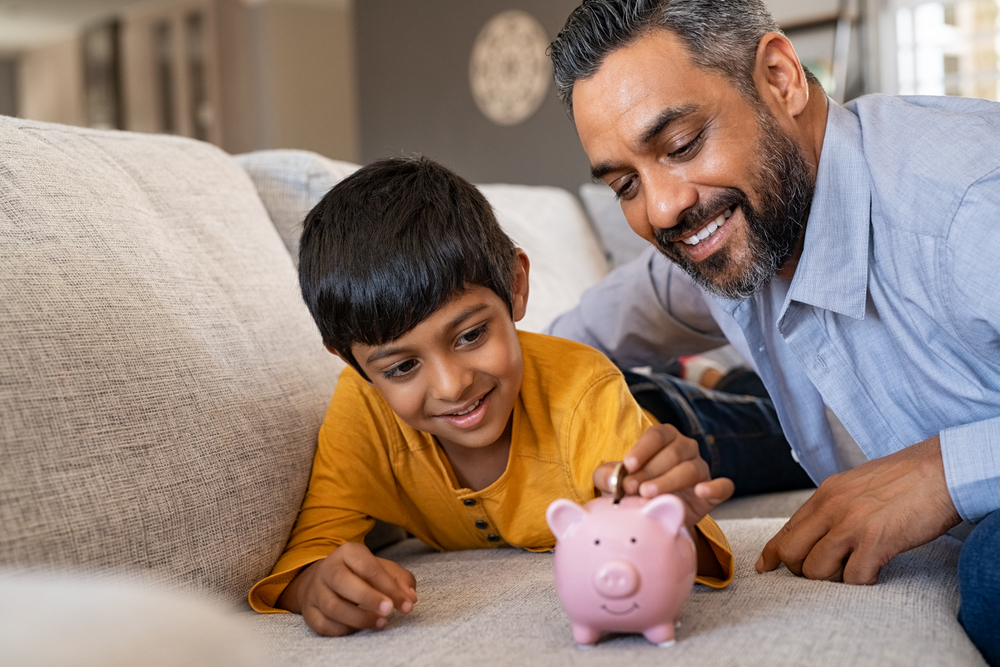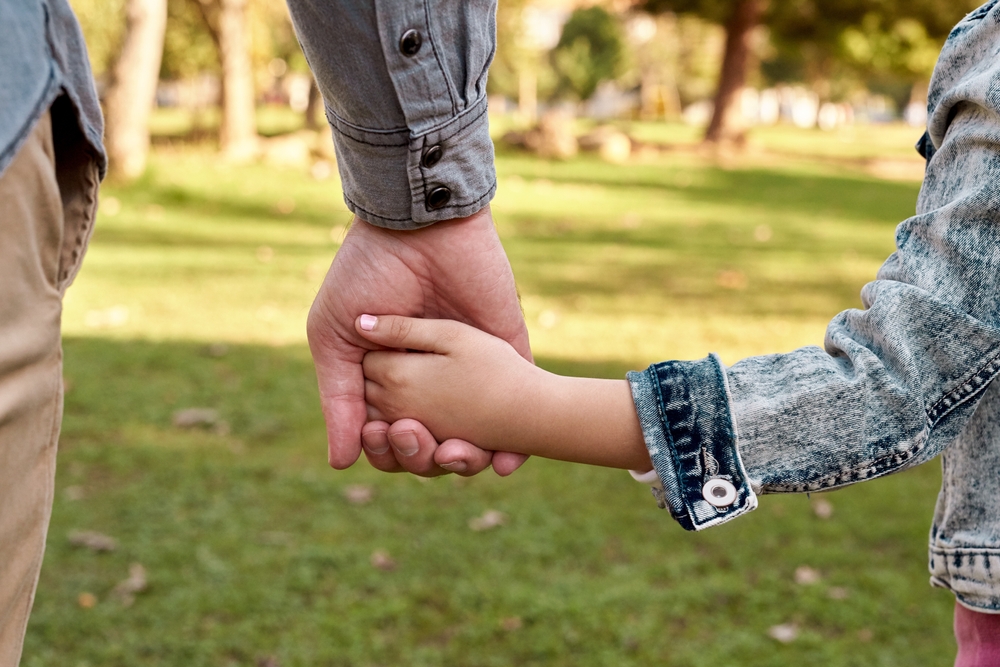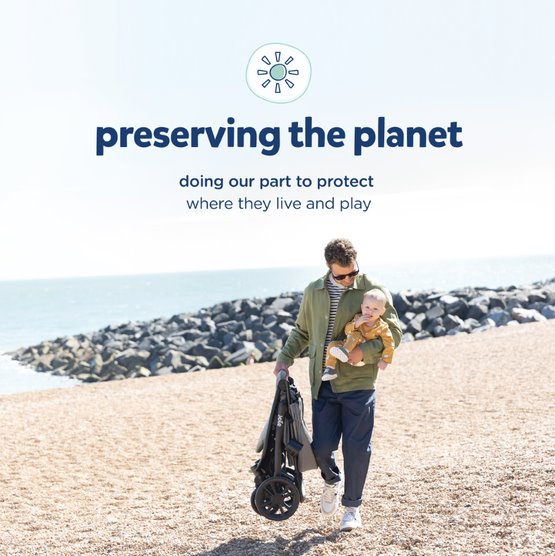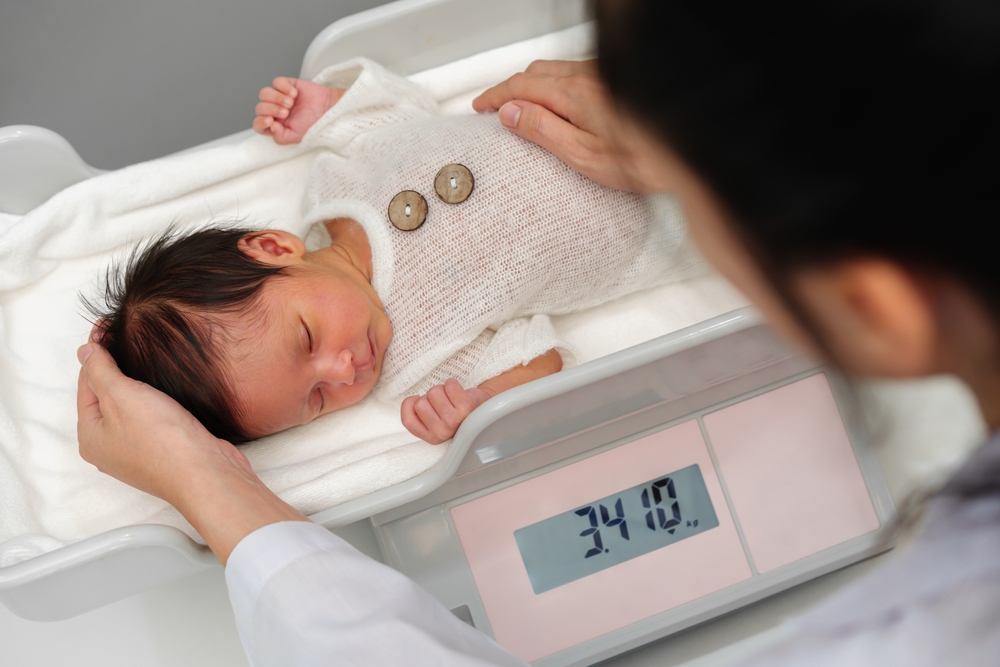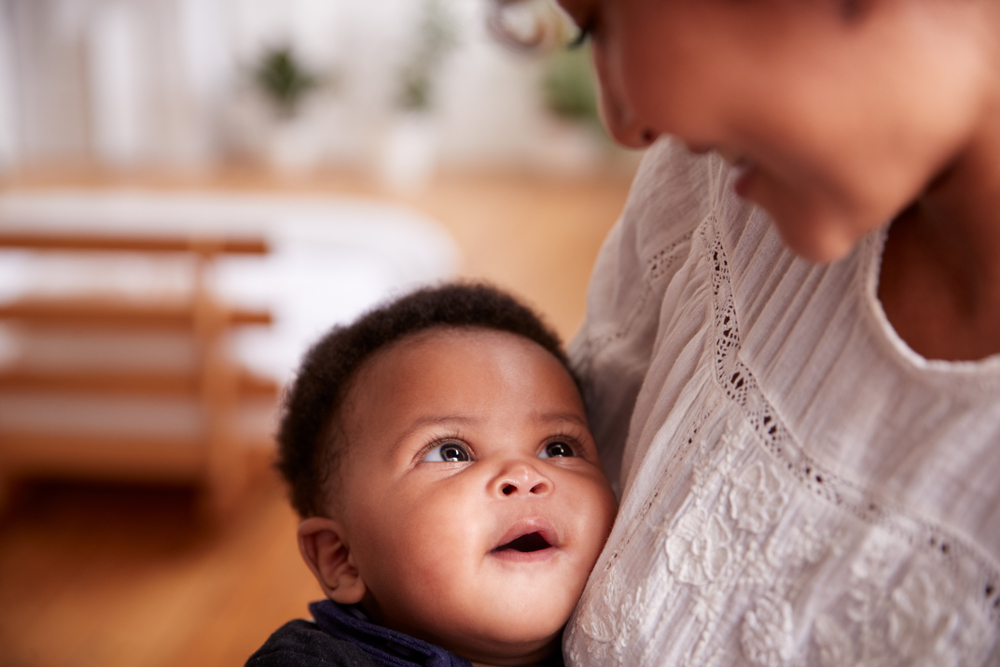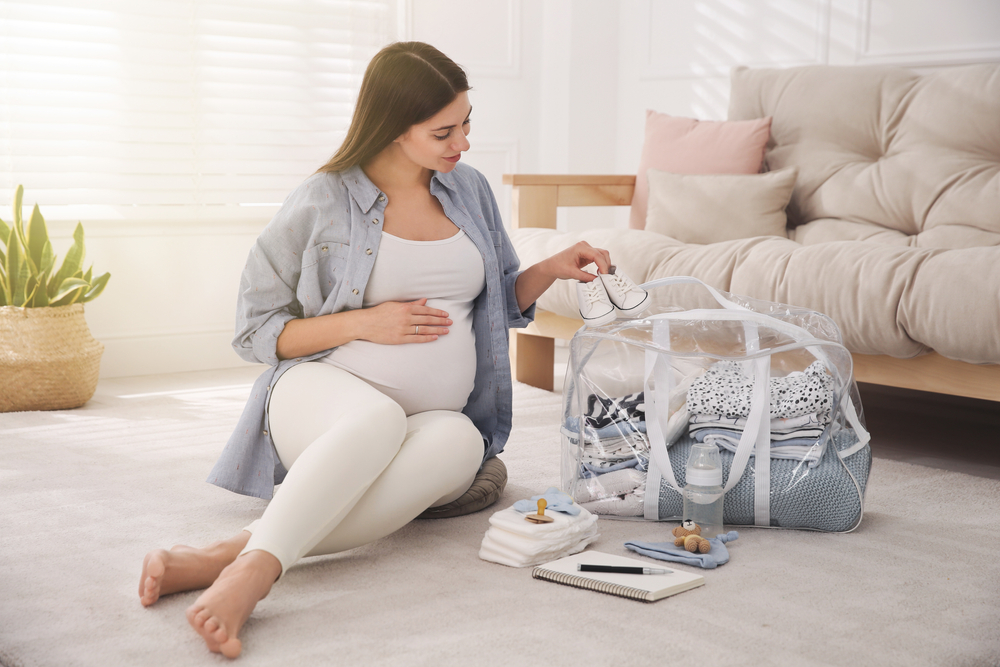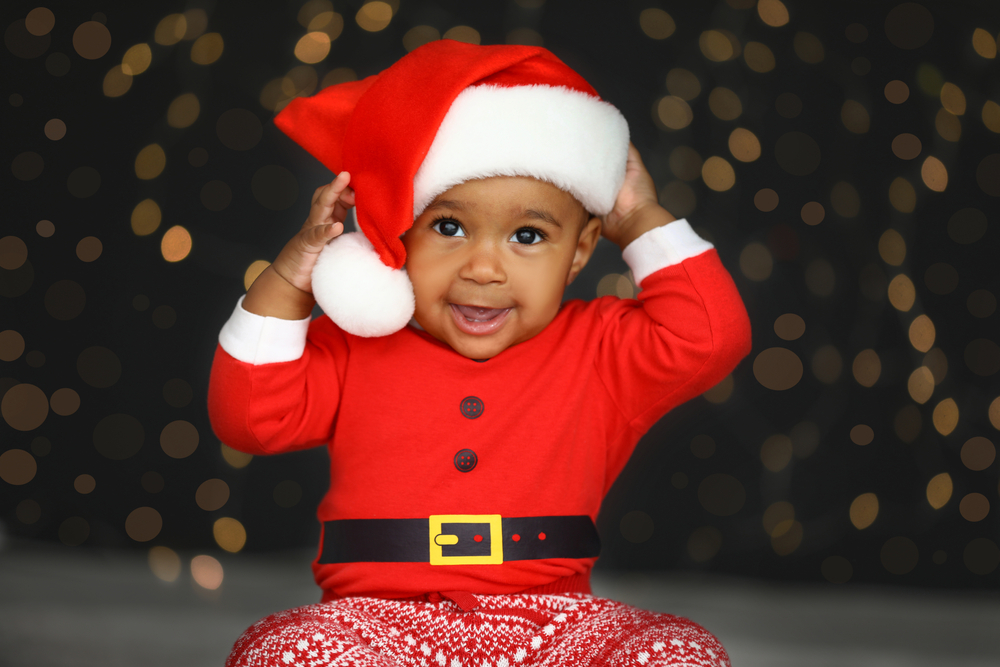The next 12 months are going to be super special. There will be millions of questions running through your mind like when will my baby smile or when do babies sit up? Your baby is going to learn, hit many milestones and it’s going to be incredible to watch! From their first word to the first time they start crawling about; this is going to be your biggest adventure yet! There will be many cuddles, bonding time and love. However, they’ll also be followed by tear tantrums and changing nappies. Nevertheless, this all part of parenthood and you should cherish every single moment. Read on for a guide on those precious firsts, when they’ll happen and how to capture the moment.
Smiles and laughter
After two months of restless nights and 24/7 lulling, you’ll have seen your little one’s crying face many a time. Now, you’re longing for that sweet smile. Normally, at 2 months they begin to respond to you by smiling! There are many ways to trigger this delightful moment. The sound of your voice or your face is all it takes to trigger their grin.
Be prepared to get used to the sound of your baby crying at first. Don’t worry though, a few months down the line and you’ll be rewarded with a treat. By the time they’re 4 months, you can look forward to another sound, perhaps the purest you’ll ever hear – their giggles.
The perfect night’s sleep
A milestone all parents look forward to is that first, full night’s sleep. In a dream world, you’d want your newborn to sleep all night. However, it’s unrealistic and in fact, unhealthy to hope for this. Though, relief is not far away! By 4-6 months, most little ones are capable of snoozing all through the night.
When can babies sit up
Tots spend a lot of their time on their belly at first. Around 5 or 6 months, most can sit up with assistance – both by resting on their hands or against furniture. Normally, by 7-9 months, babies can sit up on their own without a parents help.
Crawling
If you’ve got an 8-month-old baby, get ready for the toughest workout of your life! You’ll find yourself chasing your suddenly, very energetic tot around the house. By 9 months, most little ones can crawl using both hands and feet. Although, be aware that some never actually crawl. Instead, they prefer to wriggle around. Crawling is not an essential milestone. Infants who want to scoot about still tend to achieve other milestones on time.
Waving ‘bye-bye’
The wave is actually a very important milestone. It’s not just a cute, little gesture – it’s a genuine understanding of language. By 9 months, most tots start to make the link between noises, actions, and the meaning behind it. At this time, your little one begins to recognise that waving is linked to the phrase “bye-bye.”
Finger food
There comes a time where babies are ready to start feeding themselves. Between 9-12 months, they build better control over their hands and fingers. This makes it easier to grab any object in sight – like finger foods! Unfortunately, they’ll probably want to put everything they see in their mouth. So, when they reach this stage, environmental safety should become top priority for parents.
Standing up
It’s been a whole year of enjoying your precious angel’s company. By this time, they may be able to stand without support. They also to start to cruise about, holding onto furniture. In the time before they walk freely, babies may devote hours to cruising before they can master it properly.
The first word
The words any parent longs to hear is “mama” and “dada.” Nothing warms your heart more than hearing your baby call your own name. You can expect this to happen around the one-year mark. By this time, most tots can say at least one real word and enthusiastically mimic others. Be prepared, it won’t be long until your little one is saying absolutely everything on their mind!
Ways of capturing the special moments
Knowing when to take a picture or record a video isn’t an easy task. Having a few, unique ways in mind to capture your baby’s milestones, helps to alleviate that pressure.
- Create an email account
Make a new email account for your little one. Then, whenever you’ve got a quick moment, send a quick email accounting the day you’ve had together and attach a photo or video. When your sweetheart grows up, they can go through all the memories you’ve documented for them. - Write milestones on a calendar
A calendar is a great and accurate way to keep up to date with the goals they reach. You can document things like the first time your child lost a tooth and be confident about the exact date. - Keep a journal
Writing a diary for your little one is a very sentimental way to document milestones. You can express feelings and describe moments in detail. This way you can look back and relive those feelings in the future.
These milestones are goals for you and your little one to focus on during their first year. Keep in mind, your baby might be ready for some sooner and others later. There’s no rush, just take it easy and enjoy this momentous time in your child’s life. If it takes longer for your baby to reach any of the milestones, don’t panic! Just enjoy this momentous time in their life to grow and learn together. You’ll never get these years back.
Your Baby: Months 1 to 3
After bringing your gorgeous babe into the world, it’s natural to start thinking about when he or she will begin to do things. When will their tiny fingers curl around yours or close into fists? Or when will your little one first react to a loud noise? Your job is to help their development and let them know that the world is a friendly place, so they can learn to feel safe and loved. Remember that babies learn and develop far quicker than expected, and it won’t be long until you have a walking and talking mini you right in front of you!
However, before we get to that stage, we’re going to look at the first three months of your babe’s development.
How Much Will My Baby Grow Between 1 to 3 Months?
Keep in mind that little ones will all grow at a different pace. However, the following is a rough guideline for boys and girls aged 1 to 3 months:
- Weight – around about 1.5 to 2 pounds each month.
- Height – around about 1 inch each month.
- Head size – around about 0.5 inches each month.
Your bub will go through periods where they’re hungrier and fussier than normal. Don’t panic, this is absolutely normal! This increase in wanting to munch away means your little one is going through a growth spurt. If you’re breastfeeding, you may find they want to eat more often during certain times of the day, and sometimes, it could be every hour – this is called cluster feeding. Formula-fed babes may also want to eat more often, or you’ll find they want to drink more formula than normal during feedings.
Between 1 to 3 months, you’ll start to learn the signs that show that your bub is hungry or full. You’ll know your child is hungry when they seem:
- Restless
- Cry a lot
- Stick out their tongue
- Suck on their hands and lips
You’ll know your cutie is full when they no longer seem interested in being fed or they fall asleep at the end of a feeding session. Remember – little ones’ tummies are teeny tiny, so they need to be burped after feedings to let go of gas that could cause discomfort.
During 1-to-3-month check-ups, your doctor will measure your bub’s weight, length and head size to check their growth against a standardized growth chart. Your little one may be large, small or medium-sized when compared to the growth chart. However, if this growth pattern stays consistent, chances are your sweetheart’s progress will be just fine.
If your babe was born prematurely, remember not to compare their growth and development to a full-term child. Premature little ones will need to be observed more closely and may need to be weighed more often during their first few months, to check that their growth is on the right track.
1 Month Old Baby Development
Let’s start with your 1-month-old baby:
Hearing
Of course, your little treasure will have been able hear you and all the outside noises whilst in the womb. However, their hearing will have developed even more so that they can hear you loud and clear now that they’re finally out in the real world. Make sure you continue to talk to your cutie frequently and don’t shy away from normal household jobs. In fact, it’s good for your bub to hear noises like hoovering, as eventually they’ll need to get used to it. And if you shake a rattle or clap your hands, you may even be lucky enough to see your baby’s reaction. Whether that’s a slight movement or a blink – it’ll be a magical moment you won’t want to miss!
Vision
Even though everything will look quite fuzzy through your bub’s eyes, they can still see at around about 30cm. If you lean in nice and close, your cutie will be able to see you. Although, your features won’t be in HD detail at this point! They’ll also be able to track your finger or an object if you hold it close enough into their line of vision. And if you’re lucky, you may even witness your little one follow it with their eyes and turn their head. Keep in mind that this can sometimes make babies look a little cross eyed. However, it’s nothing to worry about as focusing on something at their tender age takes a lot of practice and effort!
One-way conversation
Soon, your cherub will start making noises – and this’ll be an exciting milestone to hear for the first time! It won’t be talking as such of course, but making little murmurs, gurgling and grunting will still be a jumping for joy moment for all mummies and daddies. As your baby gets used to the noises they’re making, as well as picking up what’s going on around them, they’ll start to utter more recognisable words after a few months. But in the meantime, keep chatting away and interacting with your babe, because if nothing else, it’ll tire your bub out for bedtime. And that means more well-deserved rest for mummy and daddy!
Keep in mind that your bub will mainly continue to communicate through crying at this stage. Listen closely and you’ll be able to decode their different teary noises. The basic to remember is that a short, low-pitched wail that seems pleading typically means that they’re in the mood for food. On the other hand, whiny, nasal, continuous tears are your little one’s way of telling you that they’re sleepy or uncomfortable – it’s either time for bed or a nappy change!
Heads up
Although your bub’s muscles are still quite weak, you’ll notice that they may start trying to move their head and support themselves more and more as each day passes. This will probably only be for a few seconds at a time. However, it’s still an important part of their development and learning. Remember, even if your bub is trying to support their own head, it’s still super important that mummy and daddy carry on supporting their heads too. You can stop supporting their head once they have built up enough neck strength (typically around 3 or 4 months). However, if in doubt, always ask your doctor!
1 month old sleep schedule
For those first, and super special, couple of months, newborns won’t be able to tell the difference between daytime and night-time. This is because they haven’t developed their own circadian rhythms which basically means their body clock hasn’t set itself properly yet. This is why your little 1 month old snoozer may happily sleep for long stretches during the day and then wake up a lot more during the night. Cuties at this age can sleep from 8 to 16/18 hours every day.
Remember that your little one’s stomach is very small at this stage, so they’ll consume breast milk/formula very quickly. This is why newborns need to be fed every 2 to 3 hours to satisfy those hungry tums. Your bub should wake up regularly for night-time feeds, but if they don’t, wake them up every 3 to 4 hours to feed them. This is only until they establish a pattern of weight gain (normally within the first couple of weeks). After that, a full-term babe with no medical conditions doesn’t need to be woken up for feedings – more time for sweet dreams!
2 Month Old Baby Development
Now that those hectic and busy, and not to mention tiring, first few weeks are over and done with, chances are that you’re starting to feel a lot more human after labour! And in month two, your cutie will have discovered there’s more to life than just eating, sleeping and crying.
So, what can you expect in month two of your bub’s life?
Routine
Although it’s highly unlikely that your little one will be sleeping through the night, it’s possible that they’ll be sleeping longer between feeds. And this is where you’ll both be falling into a familiar pattern, which is super important for consistency, development and your sanity most of all! Try to stick to a bedtime routine – bath and bed by a certain time, and make sure that you’re home in time for snoozing (if you can help it). If something disturbs yours and your angel’s pattern, it could confuse them and cause a few teary eyes.
Smiles all around
Around about when your babe is two months old, you can expect to see their first social smile, and maybe even a giggle– the most heart-warming sound in the world! This is a huge reward for you being super mum of the year pushing through endless nights of crying, nappies and cleaning up sick. Your little one’s first smile is something you’ll never forget and treasure forever. And who knows, if you’ve got a camera at hand when it happens, you may even be lucky enough to capture this special milestone!
As your baby continues to grow this month, carry on playing with them – pulling funny faces, making noises and talking to them. These all help with their all-important development, and you never know, they may even start copying you. Now, that’s definitely a sight you don’t want to miss!
Check-ups
You can expect a 6-week check-up that’ll happen within their second month. Your health visitor will check the following:
- Weight, length and head size
- Eyes, heart, hips and genitals
- Ask you about how your baby is generally doing
Your check-up is a great time to ask any questions or discuss any concerns you may have. It could also be a time for you to consider going back onto contraception – unless your little miracle has already made you broody for baby number two!
Moving
You’ll notice during this month that your cherub will start moving more and more. If you shine a light, chances are they’ll turn their head to see what it is. The same goes for if you stand by their side and start talking to them. And your little smarty-pants may even be rolling over (tummy to back is normally first). Before you know it, you’ll be on watch having to stop your little adventurer from attempting to wander off all the time!
2 month old sleep schedule
Every little one’s snoozing needs are different. However, a typical 2-month-old baby will sleep a total of 14 to 17 hours a day (including 4 to 6 naps). Day and night confusion should also be lessening at this stage, and you may also see longer stretches of sleep at night – yay! Though, if your bub’s still waking up to feed every few hours or so – that’s completely normal!
After two magical months with your baby, it’s likely that you’ve started to recognise a pattern. You probably now know when your bub tends to be awake and playful, and when they prefer to snooze. Therefore, at this stage, it’s important to slowly introduce a bedtime routine to help nurture healthy sleeping habits.
3 Month Old Baby Development
But what else can you look forward to in month 3 of your baby’s life?
Noisy baby
By now, your bub will have definitely found their vocal chords and we’re sure you’ll know all about it! They’ll have expanded their range of talking to actually string together vowels and consonant sounds – even if it’s goo goo ga ga! Aside from the crying and temper tantrums, you’re probably now familiar with gurgling and even laughing. All in all, you can expect your cutie to definitely be experimenting with a variety of different noises from this month onwards. And you should encourage this by talking to your bub as much as possible. You can even play music for them, and who knows, maybe this’ll be the start of your budding mini maestro!
Guess who
Your baby’s eyesight will now have improved enough to allow them to see their reflection in the mirror. You can help with this by encouraging them to play with mirrored toys as well as other brightly coloured goodies that’ll keep their attention/keep them engaged. It’s also super important to talk and sing to your bub much as possible. Noise and interaction in these early months will lay down the foundations of how your child will communicate and interact in the future.
Tummy time
Your babe will enjoy spending time on their tum. However, it’s best not to practice tummy time till after eating. Otherwise, you may find yourself with a messy and grumpy teeny tiny human on your hands – you’ve been warned! You may find that your little one gets a little teary and frustrated when placed on their belly, as they won’t be able to turn themselves over. However, your bub should be able to turn their head to a 45-degree angle if you call him/her. If your child does cry, don’t instantly run over to roll them over. Instead, let your little one get used to having a few moments of tummy time before coming to their rescue.
More smiles
Whilst your sweetheart is the best gift that you have – seeing their smile is another gift in itself. Though, you may have seen them crack a smile in month two, now it’s more than likely that they’re smiling more often at you, and even passers-by! Their little grins will now be because they’re replicating and copying you. Make sure when you’re chatting away to your cherub, that you use your facial expressions, like smiling, to show what you’re trying to say to them. This is all part of the learning curve for little (but clever) minds!
Arms and legs
After being squashed up in a small space for so long, your little one still probably hasn’t realised they’ve got teeny tiny arms and legs. However, after a short amount of time, they’ll start to notice that they have these additional limbs and they’ll be fascinated by them! Make sure to encourage this development by popping a rattle or toy in their little hands to see if they’ll grip it. Watch the excitement on their face as they try to grab it off you – it’s adorable to say the least!
3 month old sleep schedule
Your 3-month-old bundle of cuteness will continuously be changing. Not only will they be outgrowing nappies and onesies at a speedy pace, but their sleep requirements are evolving too. Every little one is different; however, a typical 3-month-old babe needs between 14 and 17 hours of sleep in a 24-hour period (including 3 to 4 naps totalling 4 to 6 hours). Still, it’s completely normal for a 3-month-old to snooze a little more or less than that. They may sleep also sleep for longer at night, maybe 5 hours, or even a little more, at a time. Don’t panic if your babe is up more regularly though — some little ones will still wake up at this stage because they’re hungry.
Your baby’s first few months will fly by – so make sure to treasure every single moment! From their first smile to tummy time fun, you have so much to look forward to. In the first few months, you’ll have mastered how to spot the signs that your babe’s tired or hungry, and you’ll have found your way round a dirty nappy. These are huge achievements – give yourself a pat on the back! And whilst the first 3 months can be both tiring and blissful, the next several months will be just as amazing and hopefully a little less exhausting. Remember, no matter what stage your little one’s at, the most important thing is to enjoy it!
Your Baby: Months 4 to 6
Notice your little one doing anything new? Months 4 to 6 of your baby’s life will include lots of big strides in development – yay! Now that the newborn days are behind you, you can look forward to your baby becoming more aware and mobile. Whether it’s smiling from ear to ear when they see you, rolling over or making a fuss when mummy or daddy leaves, each day of months 4 to 6 will bring exciting new adventures. And each one, no matter how big or small, will help your cutie to learn more about the world around them.
With the first three months done and dusted, let’s explore months four to six of your little one’s life in a little more depth.
How Much Will My Baby Grow Between 4 to 6 Months?
Whilst all little babes will grow at a different pace, the following is a rough guideline for boys and girls aged 4 to 6 months:
- Weight – around about 1 to 1.25 pounds each month (by 4 to 5 months birthweight will have doubled).
- Height – around about 0.5 to 1 inch each month.
- Head size – around about 0.5 inches each month.
Your 4-month-old babe will remain on a liquid-only (or mostly) diet. However, some mummies and daddies start to introduce yummy solids once their little one hits 4 months old. If this is something you’re also considering, you must check with your doctor first. Experts advise that most little ones wait until they’re 6 months old to begin munching away on regular food. And in addition to age, other signs to look out for that shows your cutie is ready for solid foods include:
- Are they holding their head in a steady, upright position?
- Are they able to sit up without support?
- Are they mouthing their hands or toys?
- Are they showing an interest in food by leaning closer and opening their mouth?
If you speak to your doctor, and they give the go-ahead with spooning up solids from month 4, remember that your little one doesn’t need more than a tablespoon of food. One spoonful of baby cereal, fruit or veggies once or twice a day will be enough to get their tastebuds tingling. After all, these solid foods are only for practice, not for nutrition. Your babe’s growth will still be fuelled by the trusty breast milk or formula.
Remember – if your little one doesn’t fall into the average weight range for babes aged 4 to 6 months, and if their doctor isn’t worried, you shouldn’t be either! Every cutie’s growth pattern is different and that’s ok! Every baby is one-of-a-kind.
Feeding Cues
Between 4 to 5 months, you’ll start to learn the signs that show that your bub is hungry or full. You’ll know your little one is ready for fuel when they:
- Put their hand to their mouth
- Turn their head towards breast/bottle
- Puckers, smacks or licks lips
- Clenches hands
And if they’re full, your baby may do the following:
- Close their mouth
- Turn their head away from breast/bottle
- Relax their hands
When your cutie hits that all-important 6-month milestone, look out for these signs that they’re hungry:
- Reaches for/points towards food
- Opens their mouth when offered a spoon/food
- Gets excited when they see food
- Uses hand movements/makes sounds to let you know they’re still hungry.
And once your babe’s tummy is satisfied, watch out for the following signs that they’re full:
- Push food away
- Close their mouth when food is offered to them
- Turn their head away from food offered to them
- Make hand movements/sounds to let you know they’re full.
4 Month Old Baby Development
Let’s start with the 4 month baby development of your bubba:
Colour savvy
Fun fact – once your cutie hits 4 months old, they’ll be able to notice differences in shades of colour – particularly red and green. Plus, they may even start to favour certain ones. Maybe you’ll get to witness the excitement on their face when they see pink. Or perhaps greens will get their hands clapping for joy! Whatever happens, being able to distinguish between different shades of colours is a huge milestone.
Teething
Heads up to the tooth fairy – teeth are on their way soon! From about 4 months, you may see your little one’s first signs of teething. Prepare for dribbling, sore and red gums, and red cheeks – so have the teething toys at the ready. Although, you probably won’t see that very special first tooth appear for another month or so.
Elevated attention span
Your cherub will now start to focus on things more and more, paying more attention to things that they may see on TV, mirrors, toys and different people. Encourage your baby on this exciting journey by continuing to vary what they see and play with, as well as giving them plenty of face-to-face attention when talking to them. Lots of cooing and eye contact is a must with your little beauty!
Movement and head control
During tummy time your cutie will now probably be able to rest on their forearms for a couple of minutes. This is a fantastic strengthening exercise to prepare their little muscles for all that crawling about you’ve got to look forward to later down the line! Around about this time, your babe will also surprise themselves by rolling over from their belly and onto their back for the first time. And when this happens, don’t forget to shower your little high-flyer with lots of praise! Your baby’s teeny tiny legs are growing stronger each day, and if you hold them in a standing position, they’ll be able to push down and support their own body weight temporarily.
Laughs all around
Many babes will laugh out loud for the first time when they’re around about 3 or 4 months old. However, other little ones may take a little longer to share their first giggle – and that’s ok! Your cutie’s first chuckle may come about from something as simple as seeing their favourite toy, pet or person (that would be you!). Whilst these early sweet giggles are heart-warming to hear, they’re also rewarding for your bub, as they’ll love hearing their own voice and seeing how mummy reacts to the sounds they make.
Once your cutie has discovered how to laugh, they may laugh just for the sake of it. After all, giggling away feels good, and it’s a fun new sound to make for little ones. Not to mention, with each coo and goo, your bub is learning and practicing how to move their mouth and tongue to create different sound effects – what a milestone! Make sure to pull lots of funny faces, sing songs and blow raspberries on your babe’s tummy, if you want to encourage that cute little giggle.
Vision
By 4 months old, your little bambino will also be able to track and follow quicker movements with their eyes, perceive depth and even grab at moving objects. However, don’t forget that their hand-eye coordination may not allow them to actually hold onto the target of their attention yet.
4 month old sleep schedule
At 4 months old, you may confront a challenging experience with your little one, and that’s all due to something called sleep regression. It happens throughout various stages of infancy, with the first one happening at around about 4 months. You may find that your bub has settled into a predictable pattern of sleep but then out of nowhere signs of sleep regression may come about. These include:
- Waking up more often at night
- Refusing sleep or naps
- Increased irritability
Most of the time, sleep regressions come about due to a “growth spurt” in your little one’s brain and body. Don’t worry though! They’re temporary, and to deal with a sleep regression, all it takes is to continue being consistent with your baby’s routine and sleeping patterns.
We understand it may be difficult to stick to your bub’s routine when they’re going through a sleep regression. However, it’s best to keep on laying them down at their usual sleep and nap times, and continue with sleep routines you’ve mastered, whether it’s bedtime bath fun or a story. And don’t forget those all-important naps! The usual nap schedules at this age should include two to three naps (one in the morning and one in the afternoon) lasting around about 1 hour to 1.5 hours – though this can vary.
One very exciting 4 month baby development that may impact your little one’s slumber is their newfound ability to roll over from front to back. When your child is capable of rolling about, you’ll want to reconsider using a swaddle, as the blanket could end up untucked or unrolled – we want to keep your chicken as safe as possible! Go for a sleep sack instead to keep them wrapped up in a safe but snuggly way.
Top tip – at this tender age, make sure to lay your babe down whilst they’re awake. This is because they’ll learn more about cause-and-effect at this age, and realise that by crying, mummy and daddy will come to the rescue. Keep in mind that you may have to test the waters more this month by teaching your little one to self-soothe or fall asleep on their own.
5 Month Old Baby Development
Most doctors and experts measure a baby’s milestones at 4 months old and 6 months old. And the 5 month baby development of your little cutie’s life is very much a period of transition for both you and them. Your bub will hit lots of different physical, developmental and cognitive milestones during month five. So, what can you expect?
Hands on
At this age, your cherub will most likely be able to lift and hold an object. However, they won’t be able to unclasp and let go of it at choice yet. They may also be able to use their thumbs separately from their teeny tiny fingers, so that they can hold objects better in a ‘claw-like’ way. Be prepared for lots of toy shaking, and the noises that may follow, for example with a rattle. And in month five, they’ll also probably be able to hold objects with both their hands, as well as suck their feet when you change their nappy.
Now that your little clever clog has perfected their hand-to-mouth coordination, don’t be surprised if they’re putting everything in their mouth. They’ll suck, chew to taste and explore away as their mouth is more sensitive than their cute little fingers. Just make sure to check all toys for buttons and loose parts, as you don’t want your baby to bite them off.
Less cooing
You may have spotted that your little cutie is starting to coo less often as they experiment with making more complex sounds. For example, you’ll get used to all the ‘bubbly’ noises they begin making by putting their tongue against their lips. And at this age, you’ll also see a lot of ‘raspberry blowing’ as your bub vibrates their lips together. All of this means to prepare for cuteness overload!
Brain power
Your cherub will continue to learn about cause and effect at this age. For example, they’ll start to figure out that particular actions, like dropping food off their highchair or kicking their teeny legs, can cause a reaction. Better yet, they may even enjoy those reactions so much so that they’ll repeat them over and over again!
In month five of your baby’s life, you can also look forward to your baby smiling at people, as well as copying facial expressions like smiling or frowning. At this age, little ones will often babble and try to copy vocal sounds too, like mummy’s cooing.
5 month old sleep schedule
When your bub hits the 5-month milestone, on average they’ll snooze for about 11.5 to 14 hours each day. They should also have two or three naps during the day, and each nap should last anywhere from 30 minutes to two hours.
Some little ones are more natural “catnappers” whilst others may require a longer stretch. The good news is that by 5 to 6 months, many babes will start sleeping through the night too, meaning they’ll stay asleep for 8 to 9 hours. Mummies and daddies, now you can breathe and relax!
As your bambino begins to sleep longer during the night and also rolls over, you may be worried about their safety at night. Just make sure to put your bub to sleep on their back and not on their stomachs. And don’t forget – never leave your little one unsupervised when it comes to tummy time.
6 Month Old Baby Development
When your baby hits their 6-month milestone, you’ll probably be wondering how it’s already been half a year since your bundle of joy entered the world. And by this age, their personality will be blossoming and shining through too! A lot will have happened over the last few months and this swift growth and development has led up to some monumental milestones this month. In fact, many mummies and daddies are often overjoyed when their little ones reach 6 months old, as it means many exciting changes are on the way.
From starting solid foods to becoming more mobile, let’s explore what month six has in store for your cutie:
Familiar faces
Your sweetheart is drawn to your face from the moment they’re born (and you to theirs!). Now halfway through their first year, your baby will know familiar faces and understand if someone is a stranger. Flip through family photos, play peekaboo and have fun with mirrors! These will all hone your bub’s social and communication skills.
Expert in pulling strings
By now, your little clever clog will have become an expert in pulling mummy and daddy’s strings! They’ll hold their arms out for you to pick them up, snuggle up to you when they want to stay with you and arch their back when they want to be put down. And due to them having sufficient long-term memory of a couple of days and all the way up to 10 days, they can remember and foresee pleasant experiences. For example, when getting ready for bath time fun, they may kick their little legs, squeal and shake their head excitedly.
Sight, hearing and awareness
The 6 month milestone brings with it an understanding of ‘object permanence’, which means that your bub will look for an object they’ve dropped or dropped out of sight. This will make games of peekaboo even more amusing now that your babe will giggle with anticipation of mummy or daddy’s face reappearing from behind their hands!
Your cutie’s sight will have improved a lot at this age, to the point where they can enjoy toys with more complex features like doors, pushbuttons, winding handles and turning dials. Not to mention the fact that they’re also getting really good at judging speed and direction, as they’ll be able to grab a moving object at the right moment now.
Budding talker
Some of the bigger milestones that little ones hit at this age will be related to their language skills. Your bub should respond to sounds, string vowels together and they may even begin to say constant sounds. As well as this, they’ll be able to make noises to show their delight and displeasure, which is a good opportunity for you to pay attention to what your babe likes and dislikes!
Most little ones will understand and respond to their own names when they’re around about 5 to 6 months old, and they’ll even begin to turn to the direction of someone talking. Your cutie will also understand simple words used in day-to-day life, for example “cup,” “book” and “bottle.” If your baby isn’t quite there yet with responding to their name – don’t worry! To help your child understand words, we recommend talking, reading and singing to them from the very beginning. Even reading the newspaper out loud to your newborn will help your budding bookworm to separate sounds into words and sentences.
Foodie
Just as you’ve got the hang of breastfeeding or mastered the bottle routine, your little one hits the 6-month mark and now they’re wanting to get their tastebuds tingling! One of the most exciting milestones to look forward to once your baby turns 6 months old is welcoming solid foods into their life. If they’re showing signs of being ready for solid foods, for example sitting without support, opening their mouth for food and reaching for mummy and daddy’s food – it’s time to introduce tasty recipes other than milk. For a helping hand to wean your little one successfully, we’ve got all the tips and tricks to turn you into a weaning expert.
6 month old sleep schedule
Once your cutie’s 6-month-birthday comes around, they’re likely to be establishing their sleep at night much more consistently than they did in the earlier months. You’ll have more shuteye to look forward to as they’ll start sleeping better at night, usually sleeping for longer stretches. During this time, your bub may even go down from three naps to two naps a day. Overall, they should be snoozing for about 14 hours, and the majority of this will include about 10 hours of sleep at night and 4 hours during the day – happy snoozing!
Keep in mind that little babes at this age may also start waking up at night, whether it’s due to the teething or going through separation anxiety. At other times though, they may wake up because they’re learning a new skill and want to practice it, or it may be because their little tums need feeding. At this age, it’s ok to give your cherub water. So, if they’re waking up at night to feed, we recommend giving them a little water in a sippy cup as opposed to nursing or giving them a bottle. This will gradually stop them from waking up to feed in the middle of the night if all they’re getting is water – tricks of the mummy trade!
From month four to half a year of your little one blessing your life, your child will go through huge developmental milestones that are worth shouting about. Though, just like the first few months of them being in the world, these next few months will also fly by – so cherish every single moment. From rolling over from their tummy and onto their back for the first time to responding to their own name, the whole family are in for a treat! And best of all, your baby’s half birthday will bring well-deserved shuteye for mummy and daddy, so give yourself a pat on the back because you made it out of the sleepless nights. Here’s to the next half of your little one’s life!
Your Baby: Months 7-9
So, you’ve reached a new and exciting chapter in your little angel’s development – months 7-9! This is the wonderful time in which your bub’s motor and communication skills come on in leaps and bounds, weaning begins, and first teeth even start to emerge!
Here are just a few of the amazing things you can look forward to during these magical months.
Growth
During months 7-9 your darling will grow an average of half an inch and gain about a pound in weight every month. They’ll also add around a quarter of an inch to their head circumference each month. By nine months old, your munchkin will have added around ten inches to their birth length.
Sleep
The 7-month sleep schedule is much more reliable than that of a younger baby, meaning you won’t have to get up in the night quite so much (thank goodness!). During this time, your little one should sleep twelve to fourteen hours a day. This includes nine to twelve hours of night-time sleep, plus two to three naps a day which should each last between one and two hours. The 7 to 9-month period is when the number of naps per day can be decreased from three to two.
However, you aren’t quite out of the woods yet when it comes to difficult nights, we’re afraid! Unfortunately, at around eight or nine months old, your little tyke will go through a sleep regression. This will last a few weeks and may include:
- Lots of crying
- Nap resistance/shorter naps
- Clinginess
- Waking up in the night
- Fussiness
Whilst this sleep regression may be annoying, it’s actually a compliment! It’s caused by separation anxiety – your tot can’t sleep because they miss you! As sweet as that may be, we’re sure you still want this sleep regression over ASAP- so here’s a few tips to help.
- Tire your tyke out with physical activity during the day
- Remove distractions (like toys) from baby’s crib
- Make sure your bub is well fed
- Check your baby is dry
- Put your little one down for naps at nap time (even if they don’t sleep)
- Place your child in their crib rather than holding or rocking them to sleep
- Establish a predictable bedtime routine
Food
One of the big 7–9-month baby milestones is the gradual introduction of solid foods. At 7 months old, your baby can start to have some solid mashed or pureed food introduced into their mostly milk-based diet. There are a few key ways to check that your little one is ready for this exciting step:
- They weigh double their birth weight and are at least 13 pounds
- They can hold their head up
- They can sit upright in their highchair
- They can close their mouth around food
- They can move food from the front to the back of their mouth
As time progresses, you can include more and more yummy solid foods in your little connoisseur’s diet, and by 9 months old their diet will be a mix of solid food and milk. The NHS recommends giving your 9-month-old three meals a day, with a variety of nutrients and as little salt or sugar as possible. Food does not have to be fully pureed by this point, as you can now try your child with more mashed and lumpy food and even soft finger foods like sliced banana. Remember, these three meals a day should be accompanied by three to four daily milk feeds. Signs your little foodie is ready for this step include:
- Pincer grip (they can hold things between their thumb and finger)
- They can pass things from one hand to the other
- They try to use their spoon
- They don’t push food out of their mouth with their tongue
- They swallow food with greater ease
- They can move their jaw in a chewing motion
Motor Skills and Coordination
Your little athlete will be picking up some amazing new physical abilities as part of the 7–9-month baby milestones. These include:
- Rolling over in both directions
- Sitting up without help
- Rocking back and forth
- Turning their little head to track objects whilst sitting
- Picking up objects
- Pincer grip (thumb and finger)
- Putting weight through their feet during supported standing (or even pulling up to standing themselves!)
- Reaching for objects whilst sitting (and not falling whilst doing so)
Another fun new skill your baby may learn at this time is crawling. However, crawling is not one of the essential 9-month baby milestones, and some little angels never crawl at all- they simply go straight to walking! There are also lots of different types of crawling, so don’t panic if your sprog doesn’t adopt the typical hands and knees approach.
As your little explorer develops those mobility and coordination skills, be it picking up objects, crawling, or pulling up to stand, it’s important to be wary about their safety. This means covering plug sockets and sharp corners and keeping dangerous objects out of reach. Luckily for you, Kiddies Kingdom has all the baby safety info you need.
Communication
At this point in their development, your bundle of joy is starting to understand more and more about the world around them. They recognise familiar faces and may even be afraid of unfamiliar ones. They also recognise commonly used words such as “no.”
Some of the brilliant communication skills your sweetie may exhibit during this time include:
- Attempting to repeat sounds
- A variety of sounds and syllables in their babbling
- Following simple requests or instructions such as “put it down” or “wave bye bye”
- Responding to their own name
- Eye contact during play
- Communicative gestures like head shaking and hand waving
- Reaching their arms up toward an adult to be picked up
Your angel’s attempts to copy sounds will soon evolve into the most thrilling of baby milestones- their first word! You can help them along in this incredible process by:
- Reading stories
- Singing songs
- Pointing to and naming objects and people
- Chatting to your baby
- Asking your baby questions
- Narrating what you are doing
- Praising their attempts at words by saying “that’s right <attempted word> well done!”
Play
Playtime is a truly joyful time with your baby, and it is so adorable to see them having fun. As an added bonus, play is how babies learn! Here are a few 7–9-month-old baby toys and games to experiment with during this time to nourish your little genius’s brain.
- Noise-making toys: Toys that make a sound when squeezed or pressed are fantastic for teaching your cherub the concept of cause and effect.
- Toys of different sizes, shapes and textures
- Colourful toys: Your kiddo will love bright and vibrant toys as they are developing their ability to tell different colours apart.
- Peek-a-Boo: This game is fabulous for developing your munchkin’s understanding of object permanence. Another way to do this is by covering a toy with a blanket and then uncovering it.
During the 7-9 month period, you may also notice that your cutie has one or more favourite toys.
Teeth
One of the most instantly noticeable changes to your bub’s appearance between 7 and 9 months old is the arrival of some pearly whites! The first teeth to emerge will be the lower front teeth, followed by the upper front teeth.
Whilst your little one will surely look adorable with a big toothy grin, the teething process can be quite painful for your poppet. The NHS recommends remedying the pain with a refrigerated teething ring and notes that you should not try to use general oral pain relief gel.
Once that cute little first tooth appears, the NHS says that you should register your sprog with a dentist and start brushing their teeth twice daily.
The best way to brush your bub’s teeth is to pop them on your knee and place their head on your chest. Then squeeze a rice grain sized smear of fluoride toothpaste on a soft bristled toothbrush.
These are a thrilling few months for you and your darling, with so many spectacular milestones to enjoy. Don’t worry if your baby doesn’t hit each milestone at the exact time when expected, as each and every little angel develops at their own rate. Whatever months 7-9 have in store for your bub, Kiddies Kingdom is here for you every step of the way.

